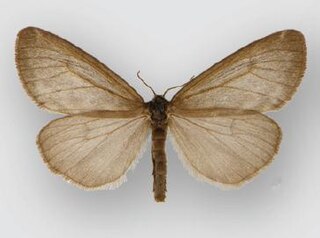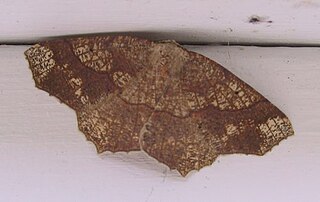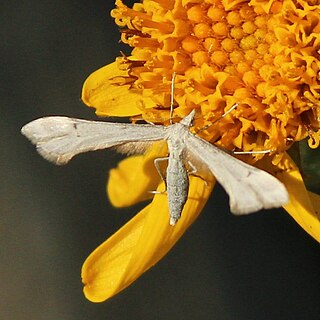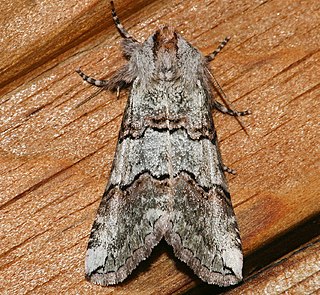
The Thyatirinae, or false owlet moths, are a subfamily of the moth family Drepanidae with about 200 species described. Until recently, most classifications treated this group as a separate family called Thyatiridae.

Euxoa medialis, the median-banded dart, is a moth of the family Noctuidae. The species was first described by Smith in 1888. It is found in North America from southern Manitoba and central Wisconsin, west to southwest Alberta and California; north to southern Alberta and south to south-central Mexico.

Dodia albertae is a moth of the family Erebidae first described by Harrison Gray Dyar Jr. in 1901. It is found in Canada, Siberia south to Mongolia, west to the Polar Urals. See the subspecies section for more information.

Acronicta hasta, the forked dagger moth, speared dagger moth, cherry dagger moth or dart dagger moth, is a moth of the family Noctuidae. The species was first described by Achille Guenée in 1852. It is found in North America in the eastern deciduous woodlands, ranging west across southern Saskatchewan and Alberta into central southern British Columbia, south to Tennessee, Wisconsin and Kansas.

Apamea cinefacta is a moth of the family Noctuidae first described by Augustus Radcliffe Grote in 1881. It is found in western North America, including in Washington and Alberta.

Autographa sansoni, the Alberta beauty, is a moth of the family Noctuidae. The species was first described by F. H. Wolley Dod in 1910. It is found in the western mountains of North America, from Alaska south to Oregon, Idaho and Arizona. Occurring mainly in the Pacific Northwest, it thrives in mid-to-high elevation conifer forest habitat, as well as some areas of coastal rain forest in the Coast range. However, it is also found in a non-contiguous range in sub-alpine forest in the Rocky Mountains, ranging from Alberta in the north, to New Mexico in the south. The wingspan of an adult ranges between 34 and 36 mm. It is widespread, and a relatively common species.

Schinia jaguarina, the jaguar flower moth, is a moth of the family Noctuidae. The species was first described by Achille Guenée in 1852. It is found on North America's Great Plains from Saskatchewan and Alberta south to Texas, eastward on coast to Florida and westward in south to Arizona. In Mexico it is found down to Mexico City.

Schinia meadi, or Mead's flower moth, is a moth of the family Noctuidae. The species was first described by Augustus Radcliffe Grote in 1873. It is found in western North America from south central Saskatchewan and central Alberta west to south central Washington, south to Arizona and New Mexico.

Macrochilo louisiana, the Louisiana macrochilo or Louisiana snout-moth, is a litter moth of the family Erebidae. The species was first described by William Trowbridge Merrifield Forbes in 1922. It is found in North America from Quebec and Maine to Florida, west to Texas, north to Alberta.
Macrochilo bivittata, the two-striped snout-moth, is a litter moth of the family Erebidae. The species was first described by Augustus Radcliffe Grote in 1877. It is found from the Atlantic coast west across the parklands and southern boreal forest of North America to central Alberta, south to Massachusetts and Ohio.

Besma quercivoraria, the oak besma, is a moth of the family Geometridae. The species was first described by Achille Guenée in 1857. It is found across southern Canada and all of the United States except California.

The American brindle is a moth of the family Noctuidae. It is found from Alaska to Newfoundland south to Pennsylvania, Colorado and Oregon.

Gillmeria albertae is a moth of the family Pterophoridae first described by William Barnes and Arthur Ward Lindsey in 1921. It is known from the mountains of Alberta near Banff.

Ceranemota is a genus of moths belonging to the subfamily Thyatirinae of the Drepanidae.

Ceranemota improvisa is a moth in the family Drepanidae. It was described by Henry Edwards in 1873. It is found in North America, where it has been recorded from northern California, western Oregon, western Washington and south-western British Columbia. Adults are on wing from late September to November in one generation per year.

Ceranemota fasciata is a moth in the family Drepanidae. It was described by William Barnes and James Halliday McDunnough in 1910. It is found in North America, where it has been recorded from British Columbia to northern California. It is also present in coastal southern Alaska. The habitat consists of coastal rainforests, mixed hardwood forests and montane riparian areas.

Ceranemota crumbi is a moth in the family Drepanidae. It was described by Foster Hendrickson Benjamin in 1938. It is found in North America, where it has been recorded from western Oregon and the Washington Cascade Range. The habitat consists of coastal rainforests and mixed hardwood forests.

Ceranemota tearlei is a moth in the family Drepanidae. It was described by Henry Edwards in 1888. It is found in North America, where it has been recorded from British Columbia and central Alberta south to central California in the west and to Utah and Colorado in the Rocky Mountains. The habitat consists of higher elevation spruce-fir and mixed hardwood-conifer forests, lower elevation ponderosa pine forests, quaking aspen forests and moist riparian areas along creeks and rivers.
Ceranemota partida is a moth in the family Drepanidae. It was described by John Frederick Gates Clarke in 1938. It is found in North America, where it has been recorded from northern Colorado.
Ceranemota amplifascia is a moth in the family Drepanidae. It was described by John Frederick Gates Clarke in 1938. It is found in North America, where it has been recorded from California.













